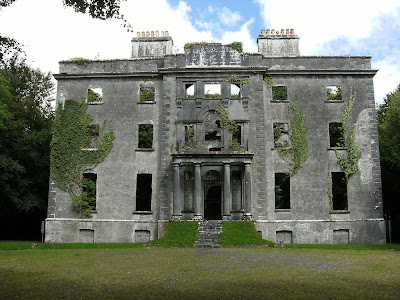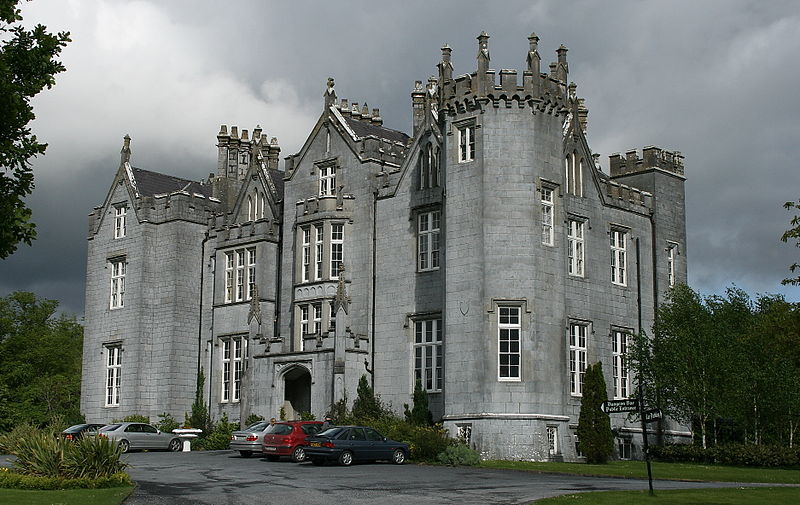THE ESMONDE BARONETS OWNED 3,533 ACRES OF LAND IN COUNTY WEXFORD
The immediate founder of the present house,
JOHN ESMONDE, of Johnstown, County Wexford, married Isabel, daughter of Thomas Rossiter, of Rathmacknee Castle, and was father of
LAURENCE ESMONDE, of Johnstown, who wedded Eleanor, daughter of Walter Walsh, of the Mountains, by whom he had two sons, and was succeeded by the elder,
WALTER ESMONDE, who espoused Margaret, daughter of Michael Furlong, of Horetown, and had, with seven daughters, four sons,
Robert;
LAURENCE, of whom presently;
James;
Patrick.
The second son,
SIR LAURENCE ESMONDE (1565-1645), Knight, abandoning the ancient creed of his ancestors, declared himself a partisan of ELIZABETH I, and a convert to protestantism.
Sir Laurence was elevated to the peerage in 1622, in the dignity of BARON ESMONDE, of Lymbrick, County Wexford.
During one of his campaigns in Connaught, having fallen in love with Margaret, the beautiful daughter of Murrough O'Flaherty, of Connemara, he reputedly married her, and had a son, THOMAS.
It happened, however, that Lady Esmonde, a devout Roman Catholic, fearing that her child might be brought up a Protestant, carried off the infant by stealth and returned to her family in Connaught.
This act of maternal devotion seems to have been not at all disagreeable to Sir Laurence, as affording him a pretext for casting suspicion on the legality of his union, that of a Protestant with a Catholic; yet, without resorting to legal measures to annul the marriage in due form, he some time later married Elizabeth, second daughter of the Hon Walter Butler, fourth son of James, 9th Earl of Ormonde, but by her had no issue.
His lordship died in 1645, bequeathing all his extensive estates to his only son, SIR THOMAS ESMONDE.
The severity and singularity of his case created considerable interest; and there is scarcely a doubt that, but for the melancholy state of civil war, usurpation, and destruction of property, at that period, the conduct of Lord Esmonde towards his lady, and the legality of his second marriage, his first un-divorced wife still living, upon legal investigation into the matter, and the accompanying circumstances, Sir Thomas Esmonde's right of succession to his father's peerage could not fail to have been acknowledged.
Before, however, that could have taken place, Sir Thomas died; and his successor had to occupy himself with entering into possession of his grandfather's property.
Sir Thomas Esmonde, as already noticed, was reared and educated with his maternal relations; and upon his uncle being raised to the peerage, to the dignity of Viscount Mayo, in 1627, Sir Thomas, who had already been knighted for his eminent services in the cause of royalty, as General of Horse in the armies of CHARLES I, was, through the Lord Mayor's influence, created a baronet in 1629, designated of Ballynastragh, County Wexford.
Sir Thomas married firstly, Ellice, widow of Thomas, 4th Baron Cahir, and daughter of Sir John Fitzgerald, of Dromana, County Waterford, and had issue,
LAURENCE, his successor;
James, of Ballynastagh, ancestor of the 7th Baronet.
Sir Thomas was succeeded by his elder son,
SIR LAURENCE ESMONDE, 2nd Baronet (1634-88), who wedded Lucia Butler, niece of the 1st Duke of Ormonde, and had issue,
LAURENCE, his successor;
Frances; Lucy; two other daughters.
Sir Laurence's seat, Huntington Castle, County Carlow, was built by Lord Esmonde in 1625, and named after the ancient seat of his ancestors in England.
He was succeeded by his eldest son,
THE RT HON SIR LAURENCE ESMONDE, 3rd Baronet, who espoused, in 1703, Jane Lucy, daughter of Matthew Forde, and had issue,
LAURENCE, 4th Baronet;
JOHN, 5th Baronet;
WALTER, 6th Baronet;
Richard.
Sir Laurence died ca 1720, and was succeeded by his eldest son,
SIR LAURENCE ESMONDE, 4th Baronet, who died unmarried ca 1738, and was succeeded by his next brother,
SIR JOHN ESMONDE, 5th Baronet, who married and died without male issue, 1758, and was succeeded by his brother,
SIR WALTER ESMONDE, 6th Baronet, who wedded Joan, daughter of Theobald, 5th Baron Caher, and had three daughters.
Sir Walter died without male issue, 1766, when the title passed to his cousin,
SIR JAMES ESMONDE, 7th Baronet (1701-66), a descendant of James Esmond, younger son of the 1st Baronet, who survived Sir Walter not more than a few days, and wedded Ellice, only daughter and heir of James Whyte, of Pembrokestown, County Waterford, and had issue,
THOMAS, his successor;
John, ancestor of the 10th Baronet;
James;
Elizabeth; Katherine; Frances; Mary.
Sir James was succeeded by his eldest son,
SIR THOMAS ESMONDE, 8th Baronet; but had no issue by either of his two wives, and died in 1803, when the title reverted to his nephew and heir,
THE RT HON SIR THOMAS ESMONDE, 9th Baronet (1786-1868), MP for Wexford Borough, 1841-7, who espoused firstly, in 1812, Mary, daughter of E Payne; and secondly, in 1856, Sophia Maria, daughter of Ebenezer Radford Rowe, though both marriages were without issue, when the baronetcy passed to his cousin,
SIR JOHN ESMONDE, 10th Baronet (1826-76), JP DL, son of Commander James Esmonde RN, MP for Waterford, 1852-76, who married, in 1861, Louisa, daughter of Henry Grattan, and had issue,
THOMAS HENRY GRATTAN, his successor;
LAURENCE GRATTAN, 13th Baronet;
John Geoffrey Grattan;
Walter George Grattan;
Henrietta Pia; Louisa Ellice Benedicta Grattan; Annetta Frances Grattan.
Sir John was succeeded by his eldest son,
 |
| Armorial Bearings of Sir Thomas Henry Grattan Esmonde Bt |
SIR THOMAS HENRY GRATTAN ESMONDE, 11th Baronet (1862-1935), DL MP, who wedded firstly, in 1891, Alice Barbara, daughter of Patrick Donovan, and had issue,
OSMOND THOMAS GRATTAN, his successor;Sir Thomas was succeeded by his eldest son,
John Henry Grattan;
Alngelda Barbara Mary Grattan; Eithne Moira Grattan; Patricia Alison Louisa Grattan.
SIR OSMOND THOMAS GRATTAN ESMONDE, 12th Baronet (1896-1936), who died unmarried, when the title passed to his cousin,
SIR LAURENCE GRATTAN ESMONDE, 13th Baronet (1863-1943), Lieutenant-Colonel, Waterford Royal Field Artillery, who married twice, though both marriages were without issue, when the title reverted to his cousin,
SIR JOHN LYMBRICK ESMONDE, as 14th Baronet (1893-1958), who wedded, in 1922, Eleanor, daughter of Laurence Fitzharris, though the marriage was without issue, when the title passed to his younger brother,
SIR ANTHONY CHARLES ESMONDE, 15th Baronet (1899-1981), who wedded, in 1927, Eithne Moira Grattan, daughter of Sir Thomas Esmonde, 11th Baronet, and had issue,
JOHN HENRY GRATTAN, his successor;
Bartholomew Thomas Grattan;
Anthony James Grattan;
Alice Mary Grattan; Eithne Marion Grattan; Anne Caroline Grattan.
Sir Anthony was succeeded by his eldest son,
SIR JOHN HENRY GRATTAN ESMONDE, 16th Baronet (1928-87), Barrister, Irish politician, who married, in 1957, Pamela Mary, daughter of Dr Francis Stephen Bourke, and had issue,
THOMAS FRANCIS GRATTAN, his successor;
Harold William Grattan;
Richard Anthony Grattan;
Karen Maria Grattan; Lisa Marion Grattan.
Sir John was succeeded by his eldest son,
(SIR) THOMAS (Tom) FRANCIS GRATTAN ESMONDE, 17th Baronet (1960-2021), Consultant Neurologist, Royal Victoria Hospital, Belfast, 1992-, who married, in 1986, Pauline Loretto, daughter of James Vincent Kearns, and had issue,
SEAN VINCENT GRATTAN, his successor;
Aisling Margaret Pamela Grattan; Niamhe Pauline Grattan.
The 17th Baronet, better known as Dr Tom Esmonde, was succeeded by his son,
(SIR) SEAN VINCENT GRATTAN ESMONDE, 18th Baronet, born in 1989.
BALLYNASTRAGH HOUSE, near Gorey, County Wexford, was originally a 17th century house, built by James Esmonde.
It was enlarged and modernized by Sir Thomas Esmonde, 8th Baronet, shortly after he succeeded in 1767.
Ballynastragh comprised three storeys over a basement, with a fine seven-bay front and three-bay breakfront.
Alterations were undertaken to the mansion by the 9th Baronet between 1803-25; and later that decade the house was embellished and slightly castellated.
 |
| The Neo-Georgian Ballynastragh House of 1937 (Image: Buildings of Ireland) |
The mansion was burnt by the IRA in 1923 and replaced in 1937 by a Neo-Georgian dwelling.
First published in August, 2018.
















